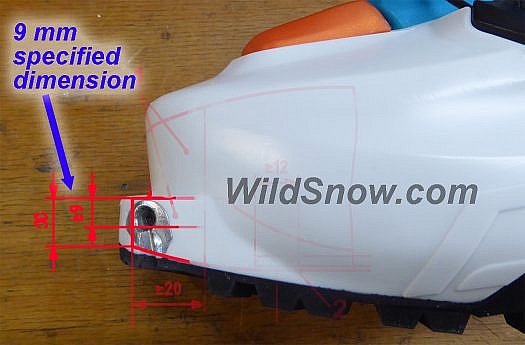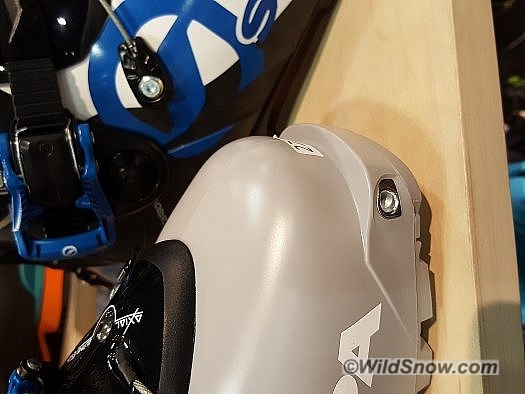“Confusion of goals and perfection of means seems… to characterize our age.”
— Albert Einstein
The perfection of means is the mission with ski touring gear. But sometimes the path to perfection has a few bumps.
Case in point: Which ski touring boots, exactly, will function correctly in a Salomon–Atomic Shift ski binding? And do the Dynafit fittings (Standard, Quick Step, Master Step) make the boot incompatible?
Short answer:Shift is built to a DIN/ISO standard that is specified as compatible with boots built to another DIN/ISO standard. So, if the ski boot in question conforms to the correct standard (ISO 9523), it is technically “compatible” with the Shift. The “Alpine Touring” category of Scarpa boots are built to match the necessary ISO standard (e.g, Maestrale, Gea). Those boots are thus “compatible” with the Shift. Read on.
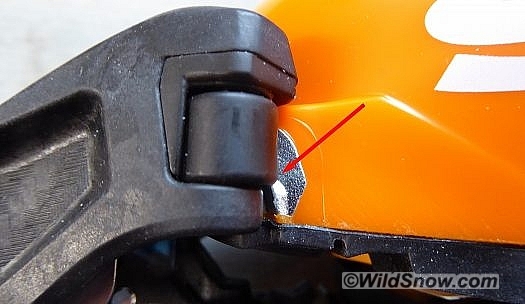
Above, Scarpa Maestrale, with Dynafit Quick Step In (QSI) tech fittings, paired with Salomon Shift. The protruding steel rib on the fittings is located just outside and under contact with the binding roller, provided the boot toe shape conforms to ISO 9523, and is THUS COMPATIBLE WITH SHIFT BINDING (see below for more info about what ISO 9523 specifies).
This is child’s play to evaluate on the workbench.
(Note that the Dynafit Master Step toe fitting, according to our evaluations, is in our opinion NOT compatible with Shift, while in our opinion the classic type tech fittings function well due to their being flush with the boot toe surfaces. Again, MAESTRALE PICTURED HERE HAS THE QSI FITTINGS AND _IS_ COMPATIBLE WITH SHIFT.
The tiny logician living inside your cortex will latch on to the “official” verbiage. Specifically, Salomon’s statement: “Offering Multi-Norm Certification (MNC) and an adjustable toe pedal, the S/LAB SHIFT is the only hybrid binding that is compatible with all norm boots on the market.” This statement can be found here.
(Oddly, the Salomon verbiage goes on to state “The Shift is also TUV-certified, delivering the safety a skier needs regardless of the type of ski boot he/she uses.” Anyone see how strange that is? It says the Shift works with any ski boot, while it clearly does not — it only works with “norm boots.” Giving Salmon the benefit of the doubt, I’d suspect this contradiction is the result of the German language marketing spreech being ineptly translated to English. So let’s move along.)
“Norm boots” means any ski boot designed and manufactured according to one (or several) of the DIN/ISO ski boot industry standards. That would include many ski touring boots (though not all). The two important ISO ski boot norms are 5355 (alpine boots) and 9523 (ski touring boots). The main distinguishing factors in “norm” boots is they have a duckbill toe of a specified dimension, and heel shape specified as well. The 9523 is described here, as illustration of how this all works.
Where the “confusion of perfection” comes from is not the ISO boot standards, but rather the presence of tech fittings, specifically the Dynafit “Quick Step In, QSI” and “Master Step” type with a small vertical rib that slightly protrudes from the boot toe. (Too much boot sole rocker can make for incompatibility as well, but we’ve not seen that as a problem other than with extremely rockered boots, and you can fix by shaving the boot sole.)
What happens with the Shift binding is the protruding rib on the Quick Step tech fitting rides next to the rollers on the binding toe wings (see photo). As it is, in my testing neither the Dynafit Quick Step nor the old style (original “Standard” Dynafit) tech fittings had any influence on Shift binding tension and release. Reason: As the boot toe moves to the side, the tech fitting that could present a problem moves AWAY from the binding roller, nicely clearing it.
Indeed, with my Scarpa Maestrale tester, boasting Quick Step fittings, I got some of the best return-to-center I’ve seen when testing the Shift. Impressive you can use a full-on touring boot in what’s essentially an alpine binding!
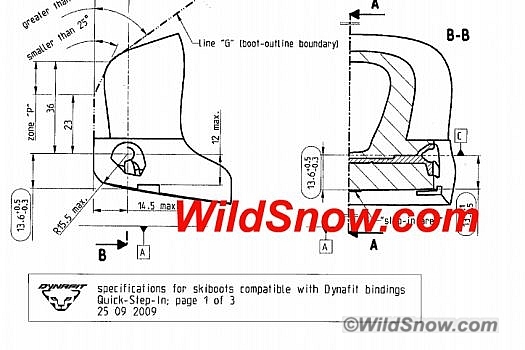
Above, sampling from the ORIGINAL voluntary Dynafit specification 25-09-2009. TUV refers to a version of this in their certificate for the Shift binding compatibility with various norms. A TUV cert costs a small fortune, including this Dynafit spec is not trivial, in my opinion it means TUV did certify for boots WITH Dynafit Quick Step fittings, and they passed. BEAR IN MIND THAT THE DYNAFIT “SPECIFICATION” IS NOT AN ISO STANDARD, IT IS A VOLUNTARY SPECIFICATION. MORE, THIS SPECIFICATION IS FOR THE LOCATION OF THE FITTINGS ON THE BOOT, NOT THE ACTUAL SHAPE OF THE FITTINGS. (Note, this internal specification by Dynafit has been updated, though I’d imagine the updated is similar in dimensions to our illustration above.) See more about this below, as the vertical location of the fittings is apparently key.
Over arching point: Printed on the TUV certificate for the Shift binding certification: “…with tech insert according to Dynafit specification for ski boots compatibility edition 25.09.2009…” which is a voluntary specification I’m told is provided by Dynafit.
(Note: The multi-compatible fittings used by Sportiva, when tested appeared to NOT be compatible due the raised area of the fitting contacting the Shift binding roller.)
All those fancy numbers and terms aside, the industry standard is that any ANY boot-binding combination is tested on the workbench, before any actual use.
While some tests get technical and require special machines, evaluating basic binding functions is child’s play, both downhill and touring. My take: If you’ve got any doubts whether a boot will function properly in a Shift binding, get a professional to look at your proposed rig. If they say yes, and the boot is certified to either or both ISO norms, just say no to the confusion and ski your shiny new gear. If the shop refuses to sell or mount due to mental challenges about what’s approved, take your business elsewhere, or do a DIY mount and enjoy. Though continue to trust but verify.
But, and it’s a big but: If you’re a ski shop, you do what the manufacturer approves and thus indemnifies you for (meaning they help you if you’re sued). Thus, solid “offical” information is key. That’s not been forthcoming with the Shift. Instead, I’m hearing two different messages.
Alternate reality 1) Something like this related to me from various individuals: “On behalf of Salomon, TUV certified the Shift to function with all ISO 9523 boots, specifically those with Dynafit Quick Step tech fittings, but also with the older “standard” tech fittings.
Alternate reality 2) “I’m told Salomon says Shift is NOT approved to function with Quick Step (nor Master Step) fittings due to the fittings protruding slightly from the boot toe radius.”
It is disappointing the army of Salomon-Atomic PR people, reps and direct employees can’t present a more coherent message. Perhaps better information will be forthcoming. Meanwhile, Scarpa has grabbed the Vibram by the lugs, so to speak, and come out with their official take. Read on.
And below please the official Scarpa take as of today, condensed and edited ((comments)):
BOULDER, Colo. (Dec. 20, 2018) – Following recent inquiries ((read: confusion)) from retailers, ski technicians and consumers stemming from new developments in ski bindings, SCARPA announces that its popular Maestrale, Gea and Freedom series ski boots follow the design specifications required for compatibility with Salomon’s new S/Lab Shift MNC 13 and Atomic’s Shift MNC 13 ski bindings.
Current standards for alpine-touring and alpine ski boots and bindings are developed by the International Organization for Standardization (ISO) and the German Institute for Standardization (DIN). ISO and DIN establish standard dimensions and specifications for the ski-boot and binding interface to achieve proper release function. TUV tests ski boots and bindings to determine whether they meet universally accepted international standards. SCARPA designs and manufactures its boots to meet these international industry standards.
SCARPA’s Maestrale, Gea and Freedom series ski boot soles meet the following standards: DIN ISO
9523, DIN ISO 5355, and/or Dynafit specification 25.09.2009, depending upon the sole of the boot selected by the consumer.The Vibram® Cayman Pro Sole complies with DIN ISO 9523 specifications and is featured on the following models: Maestrale RS, Gea RS, Maestrale, Gea, Flash and Magic.
The Vibram® Mountain Plus Sole complies with DIN ISO 9523 specifications and comes as standard equipment on the Freedom RS and Freedom SL men’s and women’s.
The Vibram® Mountain Piste Sole complies with DIN ISO 5355 specifications and comes as standard equipment on Freedom men’s and women’s. On Freedom series boots the soles are interchangeable between the Mountain Plus and Mountain Piste.
Salomon’s SHIFT MNC binding is certified by TUV to meet industry standards for compatibility with DIN ISO 5355 for alpine ski boots, and DIN ISO 9523 ski touring boots, with tech fittings that conform to the voluntary Dynafit specification 25.09.2009 (Quick Step), featured on boots such as SCARPA’s Maestrale, Gea, and Freedom series with compatible soles installed. (Note that 9523 ski touring boots without tech fittings will still function with Shift in downhill mode, while they won’t work for touring.)
((WildSnow comment: Regarding Scarpa specifically, here is a list of, in my opinion, which of their 2018-2019 boots that’ll work fine in the Shift:
Freedom, all models. Maestrale, all models. Gea, all models. Flash. Magic.))
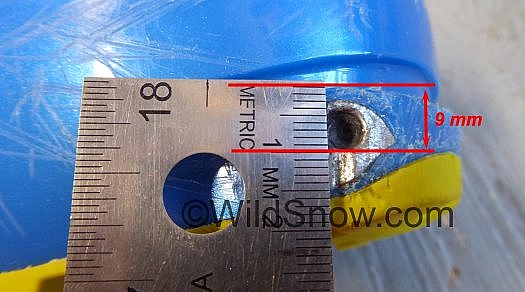
Another related concept. I’m told by insiders that the ISO 9523 norm stipulates the smooth area of the boot toe extend 9 millimeters from the top of the shelf. In the case of this Dynafit brand boot with QSI to fitting, that’s exactly the case. Further, the exact vertical dimension of the Shift toe roller area is, you guessed it, 9 millimeters. (Note this TLT 6 boot is not 9523, but it illustrates the dimension.)
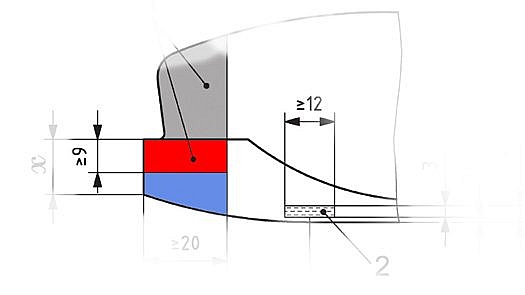
This is a derivative excerpt from standard 9523, presented here for educational purposes. Note the critical 9 mm dimension area, indicated by red, is where nothing can protrude from the boot toe surface. The area indicated by blue is where a tech fitting can protrude slightly, as the QSI does.
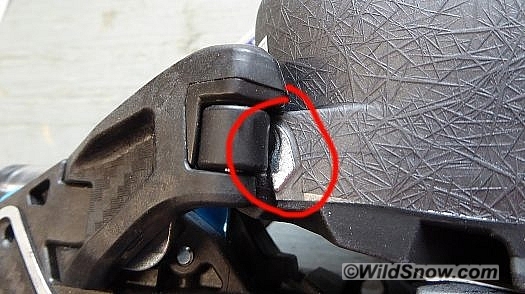
Where the perfection of means may fall short. This is the Dynafit Master Step fitting, is has a raised nib the rides under the binding roller, which does not look good to me. I find this to be ironic, as the Dynafit Master Step is clearly the “improved” fitting. More, one would assume the Dynafit is fazing out their Quick Step, meaning they’d be phasing out of compatibility with Shift! Want a helping of fitting salad, lightly tossed? Stay tuned.
Oh, also, the semi-final irony with all this is while we love the Master Step fitting heel (bolted from inside the boot), we much prefer the old style Dynafit toe fittings, the smooth ones, that allow for more sole material.
AND, TA DA, for our final irony: Next season’s Scarpa ski touring boots with DIN 9523 shaped soles (Maestrale and Gea) will fall back to using the original style “Standard” tech fittings, the ones that have a smooth profile at the toe and allow more room for sole material. I’m told they’re doing this to eliminated any doubt about compatibility. Don’t construe this as indicating Scarpa boots with Quick Step In fittings are somehow no compatible. To repeat, they are. More about the Master Step heel here. (By the way, I see no reason why Scarpa could not make their own reinforced tech fittings for the heel. Wouldn’t it be cool if they did that, and combined with old style Dynafit toe?)
(Per our evaluations above, it is wonderful seeing that Dynafit is using the Master Step heel fitting but the Quick Step In toe fitting on their new (for Fall 2019) Hoji Free boot.)
Shew, is this blog post long enough. I guess not, as I have to add one more thing. Semantics might be the source of at least some of this confusion. Myself and Scarpa are talking about “compatibility,” meaning a given boot works correctly with Shift (always after professional adjustment and evaluation). What Salomon might actually be concerned about is that they can’t indemnify* the Shift binding for the ski shop unless the boot paired with the binding has a stamp indicating it conforms to ISO 9523. I examined the 2019-2020 Maestrale and Gea variations and all have such a stamp. I’m not sure about the 2018-2019 boots. And I’m not sure about other brands as well. Where possible I’ll inspect, and update this blog post.
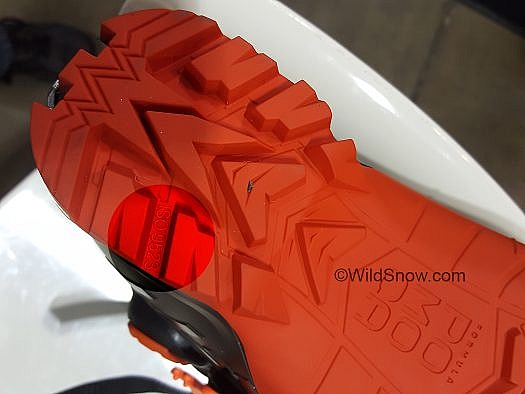
My understanding is that most boots that conform to DIN/ISO 9523 announce the fact with an insignia somewhere on the boot, usually the sole. The mystery here: Does this indicate TUV actually tested and certified the boot, or is the manufacturer simply claiming that the sole shape and configuration conforms to the 9523 standard. My guess is the latter, since the common procedure with an actual TUV cert is to stamp the TUV logo. No harm either way, so long as the consumer’s boot is tested with the chosen binding, by a technician.
(*Indemnify simply means that if a customer sues a ski shop about a binding problem, the binding maker will help defend against the lawsuit. It’s just a legal term. For example, you could have an indemnified binding and boot combination that was out of adjustment or otherwise compromised, and it would still be indemnified. What we talking about here, in this blog post, is COMPATIBILITY, meaning that in our opinion a given boot works correctly in a given binding).
WildSnow.com publisher emeritus and founder Lou (Louis Dawson) has a 50+ years career in climbing, backcountry skiing and ski mountaineering. He was the first person in history to ski down all 54 Colorado 14,000-foot peaks, has authored numerous books about about backcountry skiing, and has skied from the summit of Denali in Alaska, North America’s highest mountain.

